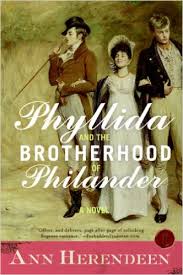 Phyllida and the Brotherhood of Philander
Phyllida and the Brotherhood of Philander
by Ann Herendeen
HarperCollins. 536 pages, $14.95
A FROTHY COMEDY of parlor-room etiquette and sexual wish fulfillment, Phyllida and the Brotherhood of Philander is the bizarro cousin of a Jane Austen novel, in which Regency manners and nuptial expectations are turned inside out. Ann Herendeen’s novel is a lively romp in which girl meets boy, boy meets boy, and everyone falls in love and lives happily ever after.
We begin with the title heroine, an open-minded Gothic novelist bursting with pluck, who shuns marriage until she receives a proposition from the tall, dark, and, yes, handsome Andrew Carrington. While fabulously rich, aristocratic, and good-looking, Carrington has a slight handicap in the marriage department—he prefers men, and is not shy about it. In fact, all of London seems not only to be aware of his predilection but to shrug its shoulders at it. This is the first clue that Phyllida is not the typical Regency romance. Yet it also indicates that, despite Herendeen’s meticulous attention to 18th-century language and manners, it is not a historically accurate depiction of gay and bisexual life of the time.
Phyllida agrees to the marriage when it dawns on her that she gets off seeing two men going at it—all the better that one of them will be her husband. But she and Andrew also enjoy a rambunctious sex life, prompting Andrew’s fellow members of the Brotherhood of Philander—a secretive, upscale “madge” (gay men’s) club—to place bets on whether Andrew, the most notorious molly of them all, will actually impregnate his wife. A slew of unfortunate events befall Phyllida and Andrew, however, keeping them otherwise occupied.
The reader, too, is busy with the dizzying tangle of characters and their indiscretions. One subplot involves Andrew’s secretary nearly raping Phyllida over a missing kitchen accounts book, an attack she keeps secret from Andrew. The villain may be connected with a secret military cipher, and a government operative belonging to the Brotherhood will do anything to recover it. Andrew spends most of his time cruising the numerous society balls he and Phyllida are forced to endure, and for her part, she’s busy with social visits to friends who, like her, are straight women married for mutual convenience to gay husbands, and loving every minute of it. Phyllida features so many secondary and tertiary characters, all with their specific intrigues, that the novel begins to resemble a London drawing room with too many overstuffed ottomans, potted palms, and knickknacks.
Herendeen does, however, use these characters to display her fantastic ear for snappy Queen’s English pillow talk. Phyllida and Andrew’s repartee highlights the importance of wit and conversational ability in maintaining a comfortable marriage, while the bitchy put-downs traded among the members of the Brotherhood of Philander are razor-sharp. The book is predicated on the old cliché about a straight woman who’s locked in unrequited love with her gay best friend (picture Will and Grace in Regency costume). Yet Phyllida ends up with the best of both worlds, a gay husband who loves her (sexually and emotionally) as much as she loves the fact that he also loves his boyfriend. Some gay readers may find this scenario a too-easy conclusion of this common fantasy, while others might be delighted that Phyllida’s wish comes true.
____________________________________________________________________
Kat Long’s first book, The Forbidden Apple: A Century of Sex and Sin in New York City, will be published in March 2009.





